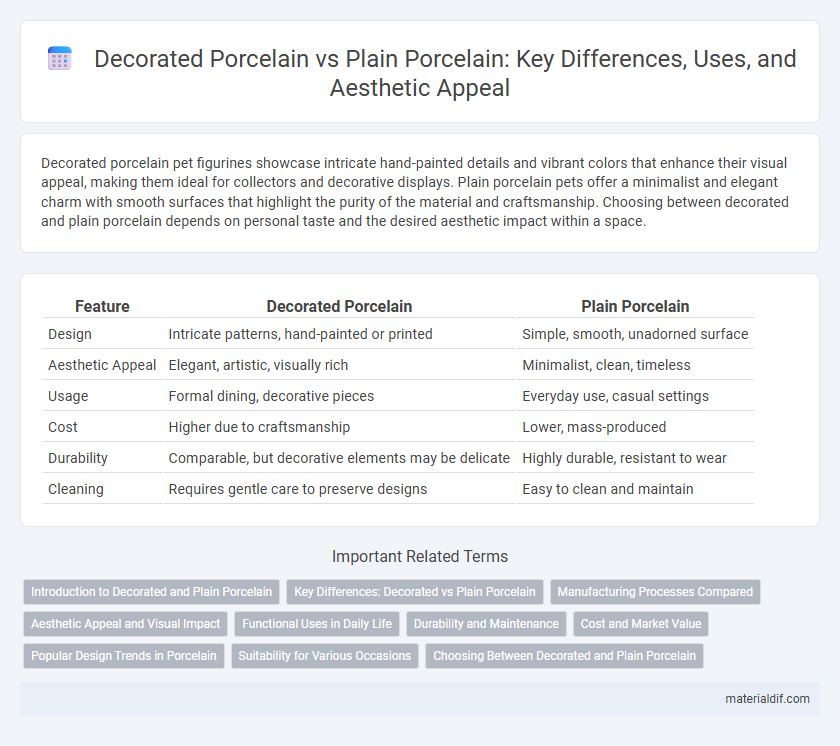Decorated porcelain pet figurines showcase intricate hand-painted details and vibrant colors that enhance their visual appeal, making them ideal for collectors and decorative displays. Plain porcelain pets offer a minimalist and elegant charm with smooth surfaces that highlight the purity of the material and craftsmanship. Choosing between decorated and plain porcelain depends on personal taste and the desired aesthetic impact within a space.
Table of Comparison
| Feature | Decorated Porcelain | Plain Porcelain |
|---|---|---|
| Design | Intricate patterns, hand-painted or printed | Simple, smooth, unadorned surface |
| Aesthetic Appeal | Elegant, artistic, visually rich | Minimalist, clean, timeless |
| Usage | Formal dining, decorative pieces | Everyday use, casual settings |
| Cost | Higher due to craftsmanship | Lower, mass-produced |
| Durability | Comparable, but decorative elements may be delicate | Highly durable, resistant to wear |
| Cleaning | Requires gentle care to preserve designs | Easy to clean and maintain |
Introduction to Decorated and Plain Porcelain
Decorated porcelain features intricate designs, colors, and patterns that enhance its aesthetic appeal and cultural significance, often showcasing skilled artistry and historical motifs. Plain porcelain, characterized by its smooth, unadorned surface, emphasizes the material's purity, translucency, and elegant simplicity, making it ideal for minimalist decor and functional ware. Both types highlight porcelain's refinement, durability, and versatility in various artistic and utilitarian applications.
Key Differences: Decorated vs Plain Porcelain
Decorated porcelain features intricate patterns, hand-painted designs, or transfers that enhance its aesthetic appeal, while plain porcelain showcases a smooth, unadorned surface emphasizing simplicity and elegance. Decorated porcelain often involves additional manufacturing steps such as glazing and firing after decoration, leading to higher production costs compared to the streamlined process of plain porcelain. The choice between decorated and plain porcelain influences not only visual appeal but also market value, durability, and intended use in tableware or collectible items.
Manufacturing Processes Compared
Decorated porcelain involves additional manufacturing steps such as glazing, hand-painting, or applying decals, which require precision and skilled craftsmanship to ensure intricate designs adhere properly during firing. Plain porcelain undergoes a simpler process focused on forming, firing, and glazing, resulting in a smooth, uniform surface without ornamental details. These differences in manufacturing impact production time, cost, and the final aesthetic, with decorated porcelain often demanding more labor-intensive techniques and quality controls.
Aesthetic Appeal and Visual Impact
Decorated porcelain features intricate hand-painted designs, vibrant glazes, and artistic motifs that enhance its aesthetic appeal and create a striking visual impact. Plain porcelain, characterized by its smooth, unadorned surface and subtle elegance, offers a minimalist charm that emphasizes form and texture over color. The choice between decorated and plain porcelain depends on the desired atmosphere, with decorated pieces serving as focal points and plain porcelain providing understated sophistication.
Functional Uses in Daily Life
Decorated porcelain often serves both aesthetic and functional roles, enhancing dining experiences with intricate designs that elevate table settings while maintaining durability for everyday use. Plain porcelain, favored for its simplicity and versatility, excels in functional applications like cookware and dishware where ease of cleaning and resistance to wear are paramount. Both types sustain essential functions in daily life, with decorated porcelain adding visual appeal and plain porcelain emphasizing practicality and long-term usability.
Durability and Maintenance
Decorated porcelain often features intricate surface treatments like glazing, painting, or decals that may require gentle cleaning methods to preserve the artwork, making maintenance more delicate compared to plain porcelain. Plain porcelain typically exhibits greater durability due to its uniform surface, with fewer chances of decorative wear or fading, allowing for easier cleaning and longer-lasting appearance. Both types maintain inherent strength and resistance to chipping, but plain porcelain is generally preferred for high-traffic or utilitarian applications due to its simpler upkeep.
Cost and Market Value
Decorated porcelain typically commands higher market value due to the intricate craftsmanship and labor-intensive processes involved in hand-painting or glazing, making it more expensive than plain porcelain. Plain porcelain, characterized by its simplicity and uniform finish, generally has lower production costs and appeals to buyers seeking minimalist aesthetics, resulting in a reduced price point. Collectors and luxury markets often prefer decorated porcelain for its artistic value, while plain porcelain finds consistent demand in everyday household use due to its affordability and durability.
Popular Design Trends in Porcelain
Decorated porcelain features intricate patterns and vibrant colors, often inspired by floral motifs, traditional Asian art, and contemporary geometric designs, making it a popular choice for collectors and home decorators. Plain porcelain emphasizes minimalism with smooth, unadorned surfaces that highlight the material's natural translucency and pristine white finish, aligning with modern Scandinavian and minimalist interior trends. Both styles embrace durability and elegance, enabling versatile applications from fine dining settings to artistic display pieces.
Suitability for Various Occasions
Decorated porcelain, with its intricate patterns and vibrant colors, is ideal for formal events, celebrations, and special occasions where elegance and visual appeal are paramount. Plain porcelain offers versatility and understated sophistication, making it suitable for everyday use, minimalist table settings, and casual gatherings. Choosing between decorated and plain porcelain depends on the desired ambiance and the formality of the occasion.
Choosing Between Decorated and Plain Porcelain
Choosing between decorated and plain porcelain depends on the intended use and aesthetic preferences. Decorated porcelain offers intricate designs and vibrant colors that enhance table settings and collectibility, while plain porcelain emphasizes minimalism and versatility suitable for everyday use. Consider durability and ease of cleaning, as plain porcelain often requires less maintenance compared to decorated variants.
Decorated Porcelain vs Plain Porcelain Infographic

 materialdif.com
materialdif.com